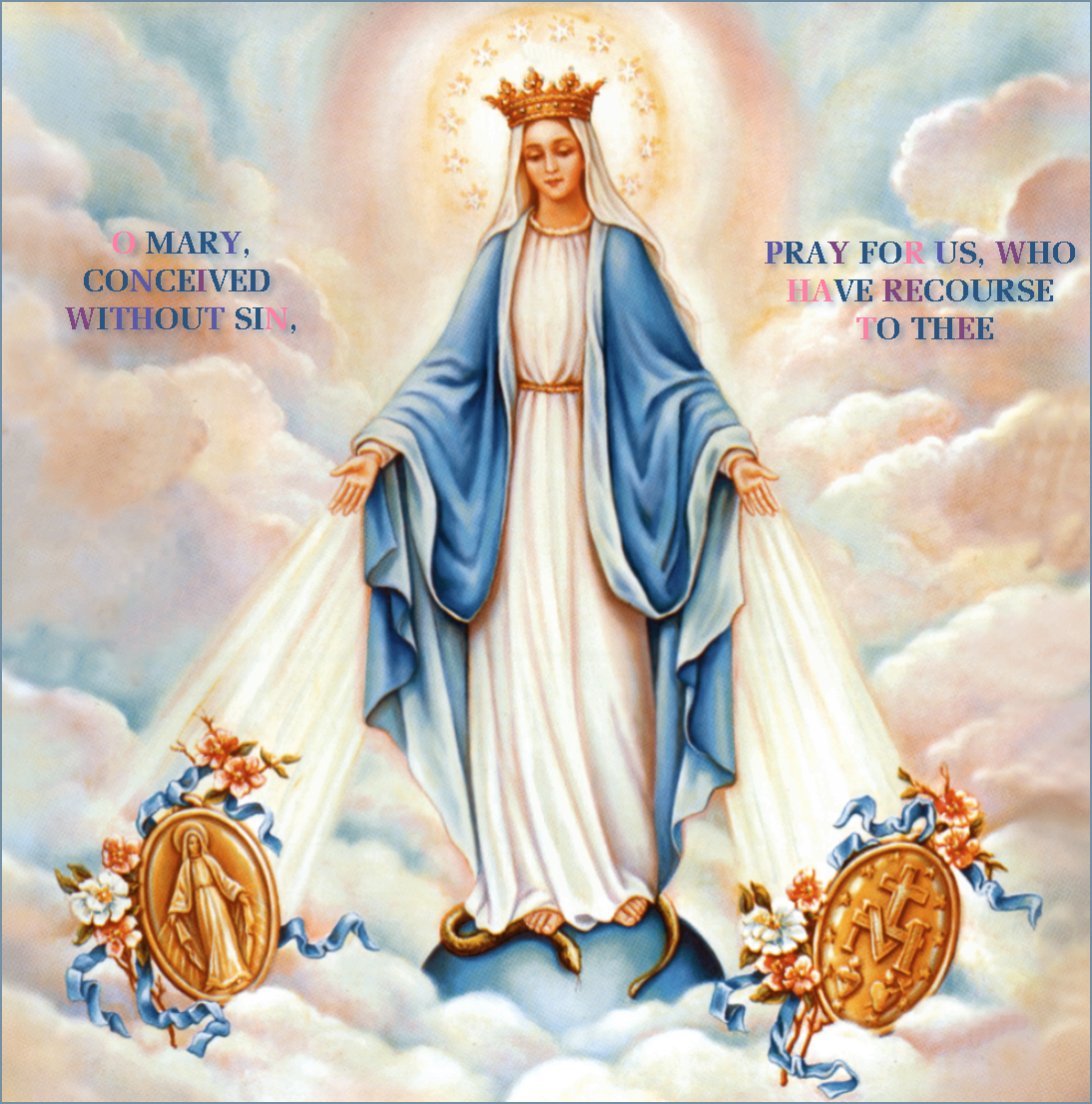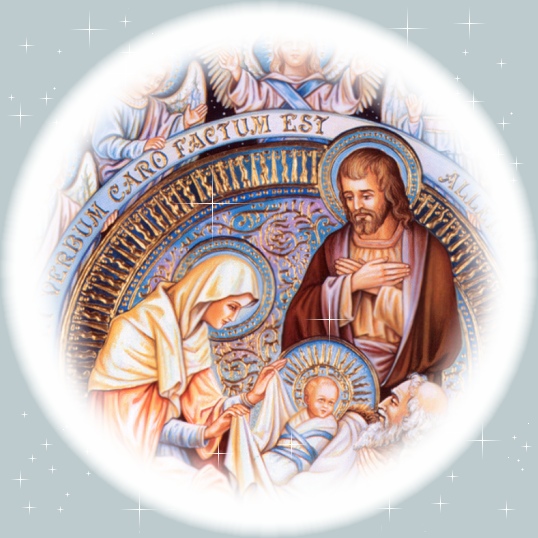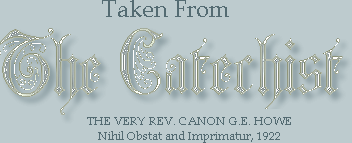
Third Article of the Creed, Part 1
"Who was conceived of the Holy Ghost, born of the
Virgin
Mary."
127. THE ROLLING ROCK.-----A pagan priest came to ask S. Gregory Thaumaturgus to instruct him in the Christian religion. This he was willing to do, and naturally commenced with the principal mysteries. Having explained that of the Holy Trinity, he came to that of the Incarnation, when he said that the Son, the Second Divine Person, had compassion on the world, lost by the sin of Adam; that He came down on earth, and took a body and soul like to ours, to the end that He might be able to suffer and die for as. "Impossible!" cried the pagan priest, "Impossible! I cannot understand that!" "But, my friend," replied the Saint, "I do not understand it myself, for it is a mystery; I believe it, nevertheless, because such truths as these are not demonstrated by reasoning, but by the miracles of God's omnipotence." "Well, since that is the case, I will believe you, if you can, by a word, make this rock, which is here beside us, go and place itself yonder on the opposite side of the stream." S. Gregory raises his eyes to Heaven, addresses to God a short but fervent prayer, and cries: "Betake thyself thither." Instantly the huge stone rolled of itself to the spot indicated. This ended the dispute; the incredulous sacrificer found nothing difficult to believe after that, in the sublime mysteries of religion, and became sincerely converted.-----Life of S. Gregory
128. CONFIDENCE OF S. TERESA.-----This Saint had great devotion to S. Joseph, and in all her wants applied to him. This is what she writes: "I took for my advocate and master the glorious S. Joseph, and I recommend myself much to him. I cannot remember having asked him for anything which he did not obtain. It seems that to other Saints Our Lord has given power to succor us in only one kind of necessity; but this glorious Saint, I know by my own experience, assists us in all kinds of necessities. Hence Our Lord, it appears, wishes us to understand that, as He was obedient to him when on earth, for he was called His father, so now in Heaven He grants him whatever he asks. Would that I could persuade all men to be devout to this glorious Saint. I have never known anyone who was truly devoted to him, and who performed particular devotions in his honor, that did not advance more in virtue, for he assists in a special manner those souls who recommend themselves to him."-----Her Life: Oct. 15
129. THE STABLE OF BETHLEHEM.-----The grotto of Bethlehem still exists, and is enclosed in the large Church of the Nativity. You go down to it by a flight of sixteen steps. It is a natural cave which has been built over and then covered throughout with marble, by the piety of the Faithful, even to the floor, in the center of which is a silver star, placed there in 1717, on which are engraved in Latin the words:
"HERE JESUS CHRIST WAS BORN OF THE VIRGIN MARY."
Kings, Emperors, Saints, and thousands of pilgrims have read them and have dwelt on this spot, to adore Him Who was born there. Many have left behind them the marks of their faith and piety, for thirty-two lamps are constantly kept burning on the very place where the true Light of the world was born.-----Mislin
130. OUR LORD'S CRIB.-----The crib in which Our Lord was laid was taken from the Holy Land to Rome, in 642. It consists of five small planks of wood, about two and a half feet long, by five inches wide. They are placed together and held by ribbons, duly sealed, covered with leaves of silver, and kept in a magnificent reliquary, in the Blessed Sacrament Chapel of S. Mary Major's, in Rome, and is one of the chief objects which pilgrims visiting the eternal city are always anxious to venerate.
131. INCIDENTS OF THE FLIGHT TO EGYPT.-----The Gospels give no details of the journey to Egypt, but tradition hands down many, e.g., As the Holy Family passed by the chief towns and cities, the idols of the pagans fell and were shattered to pieces.-----Orsini
Until some years ago, a well was shown to travelers wherein Our Lady was said to have washed the Divine Child; it was held in great veneration, not only by Christians, on account of its associations, but also by the Saracens of the country, on account of its extraordinary power of making the land fruitful.-----Giry
S. Anselm says the Holy Family settled in Heliopolis, now Cairo, where they lived for seven years in poverty and want, unknown and uncared for. Another tradition tells how one night they rested in a robbers' cave, received with rough, but kind, hospitality by the captain's wife, whose child was white with leprosy. Mary asked for water wherein to wash her Divine Child. The captain's wife thought she perceived something remarkable about her guests, and with a kind of faith, she washed her own child in the same water, and at once his flesh became as rosy and beautiful as ever mother's eye could wish to see! Years passed away, and this Dimas, for such was his name, was led into Jerusalem, a captive, and condemned to death. He was one of the two malefactors crucified beside Our Lord, the one who received pardon for his sins as he died, Paradise for his cave's hospitality in the past!-----See Faber's Foot of the Cross, 2nd dolor.132. THE VIRGIN'S TREE.-----As they were making their journey in obedience to this decree, the Blessed Virgin, bearing the Divine Child in her arms, feeling herself fatigued, sat down to rest under a turpentine tree, midway between Bethlehem and Jerusalem. Beside her was S. Joseph, holding in his hands two white doves, which were to be offered to the Lord in the temple. Whilst they sat at that place, the tree bent its branches, and spread them so as to protect the Holy Family and do homage to the Child Jesus! The miraculous tree existed for many long ages, and every pilgrim who passed that way kissed it respectfully, taking away with them some of its leaves or branches. It was unhappily destroyed in 1645: a Mohammedan Arab cut it down in order to prevent the pious pilgrims from passing over his field. The Pacha of Jerusalem being apprised of this by the Fathers of the Holy Land, gave orders that young shoots should be engrafted on the roots of the old tree, but, it was useless. The monks sold the wood in small pieces and made of it crosses and beads, which were distributed amongst travelers. They likewise caused a cairn, or heap of stones, to be erected on the spot where the Virgin's tree had stood.-----Mislin
133. S. VINCENT IN CHAINS.-----One day when S. Vincent of Paul was at Marseilles, he went to visit the poor galley-slaves who were sent to that city to fill up the time of their punishment. There was amongst them one man who seemed sadder than the others. "Tell me, my good man," said the Saint, "what is it that makes you so sad?" The man replied: "I have a wife and little family who live far, far away from this place; my heart yearns to speak to them again, but whilst I am here I can never enjoy that happiness. This is what makes me so sad." S. Vincent went to the overseer, who did not know who the Saint was, and asked permission to take the poor man's place, that he might have the happiness of seeing his friends again. This strange request was granted; the chains were taken off the poor man and put on S. Vincent, and he was made to work in the place of the criminal, till in a short time, it being discovered who he was, he was instantly set free. S. Vincent was not obliged to take the place of the galley-slave; it was his love for him that made him do so.-----Jesus Christ did more for us; out of love for us He came down from Heaven that He might, in His Own Divine Person, make reparation for our sins.-----His Life
134. THE LION AND THE LAMB.-----In ancient history we read that a merchant went to the palace of a certain king, and sold him false stones as real jewels. After some time the deception was discovered, and, in punishment for it, the merchant was condemned to be devoured by lions. On the day fixed for his death, a great multitude had assembled to witness it. The king himself was there, surrounded by his court. At length the hour fixed for the execution came, and the king gave the signal: the gate of the arena was thrown open, and behold, instead of an angry lion, a little lamb came frisking in and ran towards the man, who thought his last hour had come. A sudden enthusiasm seized upon the multitude when they saw this, for they knew that the king had shown the poor man mercy, and they cried out with one voice, "Long live the king."------Our Heavenly Father has treated us in the same way, sending His Own beloved Son-----"the Lamb of God, Who taketh away the sins of the world"-----to redeem us.-----Chisholm E-MAIL
E-MAIL
HOME------------CHILDREN'S DIRECTORY------------PENNY CATECHISM
www.catholictradition.org/Children/catechist-6.htm
